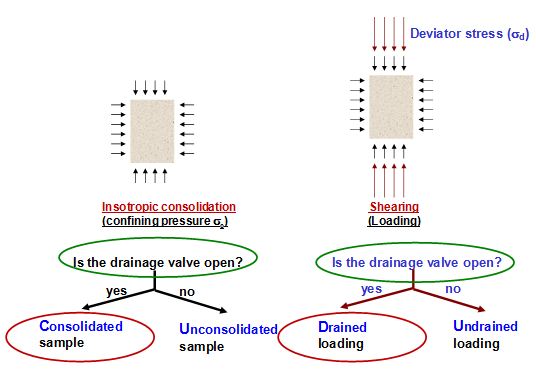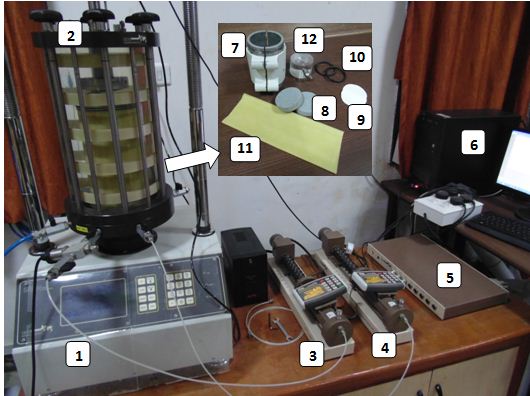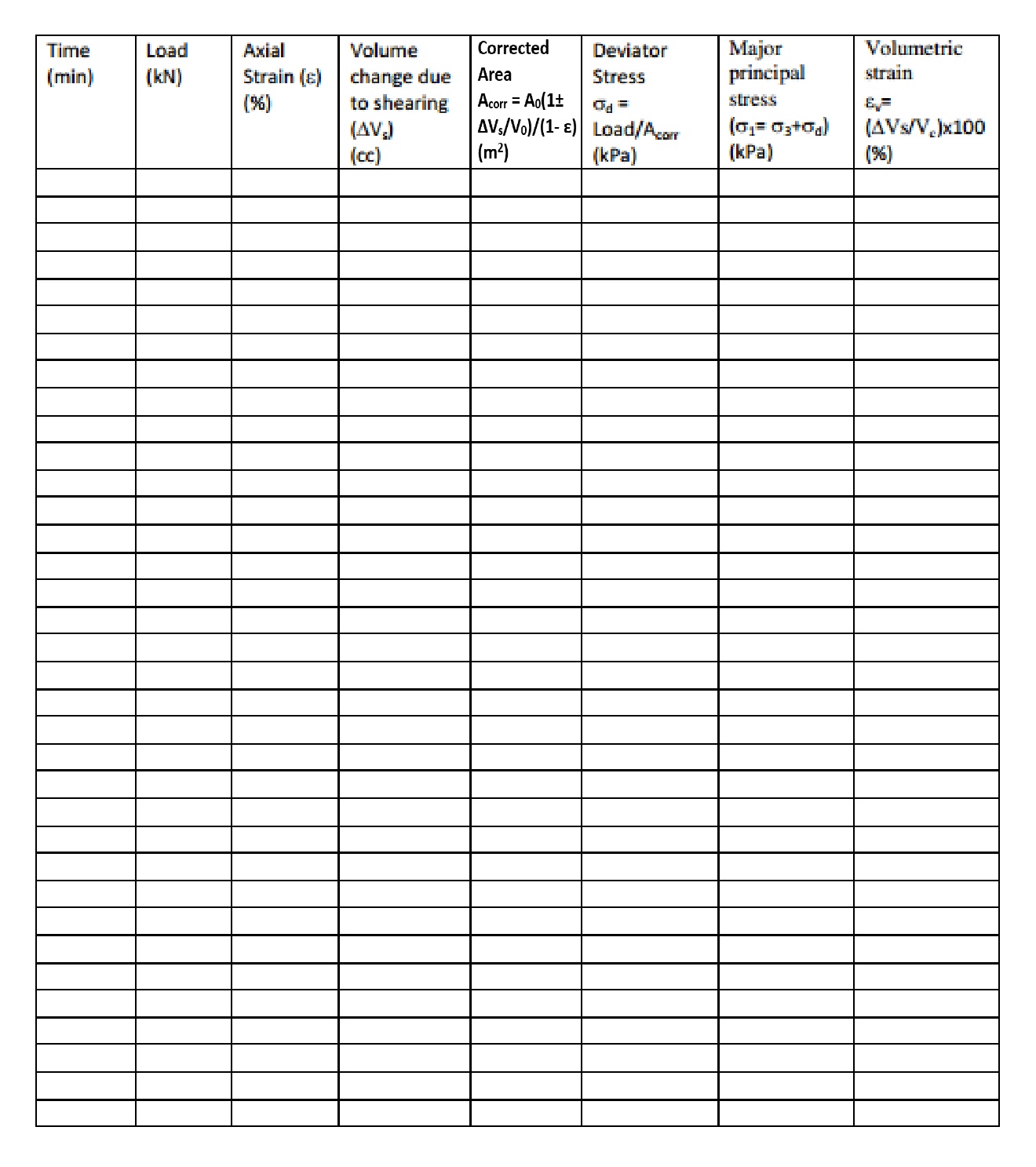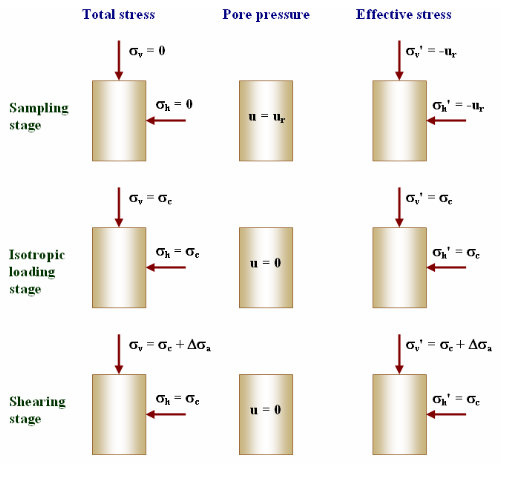Consolidated Drained (CD) Triaxial Test
Need and Scope:
Determination of strength and stress-strain relationships of a cylindrical specimen of “undisturbed” or “reconstituted” specimens. The soil specimens are isotropically consolidated and sheared in compression with drainage at a constant rate of axial deformation.
Concept:
CD tests can be performed on all types of soils. Drainage is allowed in both phases of triaxial testing; isotropic consolidation & shearing. Soil is consolidated under a chosen confining pressure; and after completion of consolidation it is tested for shear by applying deviator stress gradually at slow strain rate while allowing full drainage. It takes more time to complete a test as compared to CU test, and commonly known as “slow” test, which is seldom conducted except for research interest.

Consolidated Drained (CD) Triaxial Test
Experimental Setup:
- Loading frame of capacity of 10 t, with constant rate of movement.
- Triaxial cell
- Pore water pressure transducer
- Volume change transducer
- Data acquisition system
- Computer with Triaxial testing software
- Specimen preparation holder for remoulded specimen
- Porous stone
- Filter paper
- O-rings
- Latex membrane
- Specimen end platen (Perspex plate with silicon grease coating).

Specimen Preparation:
a)Undisturbed Specimen(UDS):
- Note down the sample number, bore hole number and the depth at which the sample was taken.
- Remove the protective cover (paraffin wax) from the sampling tube.
- Place the sampling tube (38 mm dia) extractor and push the plunger till a small length of sample moves out.
- Trim the projected sample using a wire saw, and push the plunger until a 76 mm long sample comes out.
- Cutout this sample carefully and hold it on the split sampler so that it does not fall.
- Take about 10 to 15 gm of soil from the tube for water content determination.
- Note the container number and take the net weight of the sample and the container.
- Measure the diameter at top, middle, and bottom of the sample. Find the average and record the same.
- Measure the length and weight of the sample and record.
b) Remoulded Specimen(R):
- For the desired water content and the dry density, calculate the weight of the dry soil Ws required for preparing a specimen of 38 mm diameter and 76 mm long.
- Add required quantity of water Ww to this soil.
Ww = Ws x W/100 gm
- Mix the soil thoroughly with water.
- Place the wet soil in a tight thick polythene bag in a humidity chamber.
- After 24 hours take the soil from the humidity chamber and place the soil in a constant volume mould, having an internal height of 76 mm and internal diameter of 38 mm.
- Place the lubricated mould with plungers in position in the load frame.
- Apply the compressive load till the specimen is compacted to a height of 76 mm.
- Eject the specimen from the constant volume mould.
- Record the correct height, weight and diameter of the specimen.
Testing procedure:
- The saturated porous stone disc of diameter same as the sample is placed on top of the pedestal of triaxial testing machine and the circular filter paper of same size is placed over the disc. Specimen is placed on top of the filter paper. The filter paper with porous stone is placed on top of the specimen to allow two-way drainage.
- The latex membrane is stretched in the membrane stretcher and placed on the soil specimen. O rings are placed at top and bottom of platens of the soil specimen to prevent the cell water entering into the specimen.
- The triaxial cell is placed over the base and tightened with the screws. The cell is then filled with water and a small confining pressure of about 10 kPa is applied to hold the specimen in place.
- The soil specimen needs to be completely saturated before isotropic consolidation phase.
- Saturation process consists of three steps: i) CO2 saturation, ii) Water saturation, iii) Back pressure application.
- CO2 is applied continuously for minimum 3-6 min from bottom of the specimen and then allow it to go out of the specimen from the top. CO2 replaces the air in void space of the specimen which gets easily dissolved in the water present within the specimen. The CO2 flushing process is repeated 4-5 times to ensure better saturation.
- Water saturation is done by supplying water from bottom of the specimen and allow it to go out of the specimen from the top to do proper water flushing of the specimen. The water used for flushing needs to be distilled & de-aired water.
- The force saturation is performed by applying cell pressure and the back pressure at constant increments with constant difference between these two pressures. The sample is allowed to saturate for some time (10-20 min) after each increment of cell pressure and the back pressure. This increase should be followed by a check for saturation value (B), also known as skempton’s pore pressure parameter. It is important to note that cell pressure always is higher than back pressure. The sample is said to be fully saturated if the B value greater than 0.95 can be acquired. B is the ratio of pore pressure change due to the change in cell stress (B = Δu / Δσcell).
- Isotropic consolidation stage is started by applying confining pressure. During the Consolidation stage, drainage valve is kept open and the volume change is measured until no change in volume is observed (when primary consolidation is over).
- In the Consolidated Drained (CD) triaxial test, drainage valves are kept open during shearing stage and volume change is measured throughout the test using the volume change transducer.
- The loading machine is set in motion at an appropriate strain rate based on the soil type (much lower strain rate than CU testing for same soil). Data acquisition system (DAQ) is attached with the computer. load cell & transducers of triaxial system, which records the data with the help of triaxial CD software. The experiment is stopped at around 15% strain.
- Three CD tests need to be performed at three different chosen confining pressures.
Consolidated Drained (CD) Triaxial Test
Three CD tests need to be performed at three different chosen confining pressures.
Observation Sheet:
Test 1: Confining pressure = ___________ kPa
Weight of Sample:___________________ In-situ Density: __________________
Initial Water Content:_________________ Strain rate:_ _________________
Diameter:________________________ Height:_________________________
Area(A0):________________________ Volume(V0):________________________
Cell Pressure:_____________________.Back Pressure: ____________________
Confining Pressure (σ3):_______________ Saturation value (B):_______________
Volume change due to consolidation (ΔVc):_________________________________
Volume after consolidation (Vc= V0 – ΔVc):__________________________________

Test 2: Confining pressure = ___________ kPa
Weight of Sample:___________________ In-situ Density: __________________
Initial Water Content:_________________ Strain rate:_ _________________
Diameter:________________________ Height:_________________________
Area(A0):________________________ Volume(V0):________________________
Cell Pressure:_____________________.Back Pressure: ____________________
Confining Pressure (σ3):_______________ Saturation value (B):_______________
Volume change due to consolidation (ΔVc):_________________________________
Volume after consolidation (Vc= V0 – ΔVc):__________________________________

Test 3: Confining pressure = ___________ kPa
Weight of Sample:___________________ In-situ Density: __________________
Initial Water Content:_________________ Strain rate:_ _________________
Diameter:________________________ Height:_________________________
Area(A0):________________________ Volume(V0):________________________
Cell Pressure:_____________________.Back Pressure: ____________________
Confining Pressure (σ3):_______________ Saturation value (B):_______________
Volume change due to consolidation (ΔVc):_________________________________
Volume after consolidation (Vc= V0 – ΔVc):__________________________________

Test 4: Confining pressure = ___________ kPa
Weight of Sample:___________________ In-situ Density: __________________
Initial Water Content:_________________ Strain rate:_ _________________
Diameter:________________________ Height:_________________________
Area(A0):________________________ Volume(V0):________________________
Cell Pressure:_____________________.Back Pressure: ____________________
Confining Pressure (σ3):_______________ Saturation value (B):_______________
Volume change due to consolidation (ΔVc):_________________________________
Volume after consolidation (Vc= V0 – ΔVc):__________________________________

Calculations:
- Deviator stress versus Axial strain curve and Volumetric strain versus axial strain curves are plotted for all three CU triaxial tests.
- Volumetric strain = (ΔVs/ Vc)x100
ΔV = Volume change due to deviator stress during shearing stage
Vc = volume of specimen after the isotropic consolidation or before shearing stage - Volume of soil specimen after isotropic consolidation (Vc ) can be obtained by following equation
Vc = V0 – ΔVc
where ΔVc = volume change during isotropic consolidation and V0 is initial volume of the soil specimen. - The failure point of soil specimen can be defined as the point of peak stress in stress-strain relationship of each CD triaxial test.
- Effective stress analysis is performed in CD triaxial tests as pore pressure is zero as drainage valves kept open throughout the test. Total stress is the same as the effective stress during this test.
- Modified Failure envelop is obtained by drawing q-p curve for total stress analysis
q = (σ1 – σ3)/2, p = (σ1 + σ3)/2, σ1 = σd + σ3
Pore pressure is zero during shearing in CD test, thus σ3 = σ3‘, σ1= σ1‘, p = p’ - q-p curve provides a & ζ parameters. a is intercept of q-p curve and ζ is the slope angle of q-p curve. Shear strength parameters (c & Φ) can be calculated by using following equations. ccosΦ = a, sinΦ = tanζ
Consolidated Drained (CD) Triaxial Test
Example:
CD tests have been performed on clay specimens at confining pressures of 100 kPa, 200 kPa, 300 kPa, and 400 kPa. All the tests were performed on Normally consolidated (NC) soil specimens.
The specimens were sheared at a strain rate of 0.005% per min after consolidating the specimens at chosen confining pressures. In all the tests, the saturation value B was 0.97 before starting the consolidation phase.

Figure 1. Deviatoric stress versus axial strain

Figure 2. Volumetric strain versus axial strain

Figure 3. Effective stress paths

Figure 4. Modified Failure Envelope
Results:


General Remarks
- Saturation value B must be acquired to be more than 0.95 before starting the isotropic consolidation phase in CD test.
- CD tests are performed at much slower strain rate as compared to CU tests for the same soil. The strain rate for CD test can be chosen approx 8-10 times lower than the CU test.
- It is important to have no pore water pressure generation throughout the shearing phase of CD test or in other words strain rate must be so small that pore water pressure must get dissipated quickly when specimen is subjected to compression loading in CD test.
- In CD test, volumetric strain versus axial strain relationship shows contractive response for NC soils and dilative response for OC soils. NC = Normally consolidated, OC = Overconsolidated
- Filter paper strips can also be used around the cylindrical surface of the soil specimen to allow radial drainage to improve the drainage conditions for CD tests on clays.
Consolidated Drained (CD) Triaxial Test
Theory:
The shear strength of a saturated soil in triaxial compression depends on the stresses applied, time of consolidation, strain rate, and the stress history experienced by the soil. In this test, the shear characteristics are measured under drained conditions and are applicable to field conditions where soils have been fully consolidated under the existing normal stresses and the normal stress changes under drained conditions similar to those In the test method. The shear strength determined from the test is commonly used in embankment stability analysis, earth pressure calculations, and foundation design.
The following image shows three phases of CD triaxial testing; sampling stage, Isotropic loading stage (application of confining pressure for consolidation under isotropic conditions), shearing stage (application of deviator stress, σd). Three parameters are shown at each phase of CD triaxial testing in the given diagram; total stress, pore pressure and effective stresses. ur is the residual pore water pressure entrapped inside the soil specimen after its collection from soil site using UDS (Undisturbed sampling) tube. The residual pore water pressure (ur) entrapped inside the soil mass gets dissipated when drainage valves are kept open for saturation of soil specimen (CO2 saturation, water saturation and application of back pressure). After saturation stage, pore pressure is not allowed to generate in next two stages of the test by keeping the drainage valves open during isotropic consolidation & shearing stages. Thus, diagram shows pore pressure values to be zero in second & third stage of CD test. Shear deformation stage in CD test must be conducted under low strain rate to avoid pore pressure generation when specimen is subjected to compression loading.

